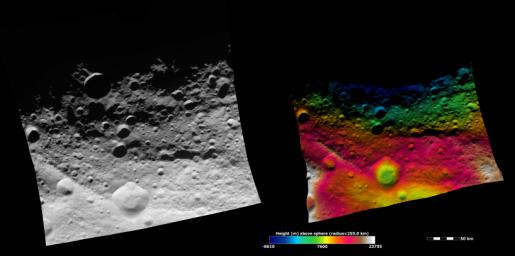
|
Topography of Vesta’s Equatorial Region I
- Click the image above for a larger view
- Full-Res JPEG (3129 x 1557) (332.2 kB)
- Full-Res TIFF (3129 x 1557) (14.6 MB)
Caption:
These Dawn FC (framing camera) images show part of Vesta's equatorial region, which contains a prominent, deep impact crater (lower center of image) and large troughs (linear depressions). The left image is an albedo image, which is taken directly through the clear filter of the FC. Such an image shows the albedo (e.g. brightness/darkness) of the surface. The right image uses the same albedo image as its base but then a color-coded height representation of the topography is overlain onto it. The topography is calculated from a set of images that were observed from different viewing directions, called stereo images. The various colors correspond to the height of the area that they color. For example, the white areas in the bottom corners of the image are the highest areas and the blue areas along the top of the image are the lowest. The prominent impact crater is set into a topographically high area defined by the red and white color-coding. Above this area there are a number of deep troughs represented by green and blue color-coding. A conspicuous trough on the left, which looks like it could be quite deep in the albedo image, is shown by the color-coding in the topography image to be only a little shallower than the area surrounding it.
NASA's Dawn spacecraft obtained the albedo image with its framing camera on August 11th 2011. This image was taken through the camera's clear filter. The distance to the surface of Vesta is 2740 km the image has a resolution of about 250 meters per pixel. The images are projected using a lambert-azimuthal map projection.
Background Info:
The Dawn mission to Vesta and Ceres is managed by NASA's Jet Propulsion Laboratory, a division of the California Institute of Technology in Pasadena, for NASA's Science Mission Directorate, Washington D.C. UCLA is responsible for overall Dawn mission science. Dawn's VIR was provided by ASI, the Italian Space Agency and is managed by INAF, Italy's National Institute for Astrophysics, in collaboration with Selex Galileo, where it was built.
More information about Dawn is online at http://www.nasa.gov/dawn and http://dawn.jpl.nasa.gov .
Cataloging Keywords:
| Name | Value | Additional Values |
|---|---|---|
| Target | 4 Vesta | |
| System | Main Belt | |
| Target Type | Asteroid | |
| Mission | Dawn | |
| Instrument Host | Dawn | |
| Host Type | Orbiter | |
| Instrument | Framing Camera (FC) | |
| Detector | ||
| Extra Keywords | Color, Crater, Impact, Infrared, Map | |
| Acquisition Date | ||
| Release Date | 2011-11-07 | |
| Date in Caption | ||
| Image Credit | NASA/JPL-Caltech/UCLA/MPS/DLR/IDA | |
| Source | photojournal.jpl.nasa.gov/catalog/PIA15041 | |
| Identifier | PIA15041 | |
